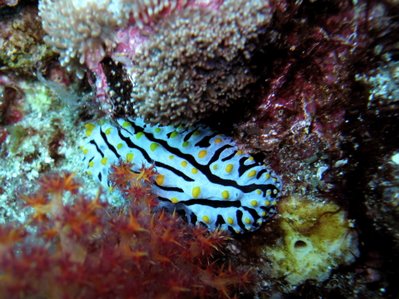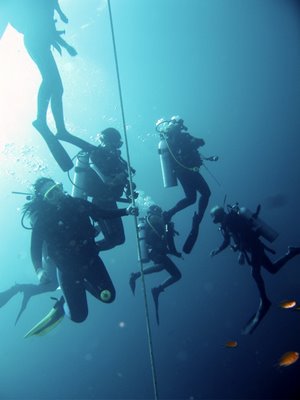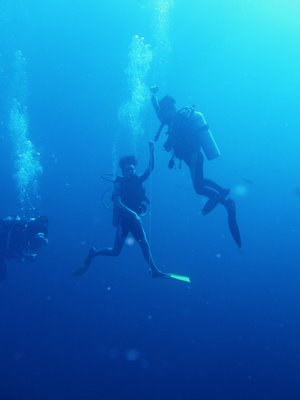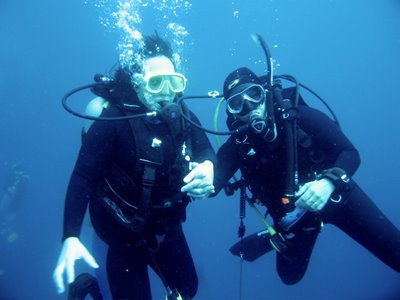
Imagine submerging yourself into the open turquoise sea, and as you finally complete equalising the air pressure in your ears, you look around to take in
this view.....

... this is why I love scuba diving so much. The infinite beauty of Neptune's world takes my breath away every time I see the flowing arms of the sea anemone dance and sway to the beat of the underwater current.

Once in a while, you get to see creatures that are quite literally, out of this world. Take this pufferfish for example. We all know that the pufferfish is one ugly dude (I'm reminded of my secondary school chem teacher, but shhhh.....); but this is not your garden variety puffer, nosiree. This is one puffer with attitude and knows it. It's called the Papuan toby or
Canthigaster papua. If you ask me, I'd call it the Angelinajolie toby (Canthigaster stealrachelshusbandii).

I almost missed this one. I was so busy focusing the camera on the shrimps (lower left) that I completely didn't see it. Thanks to Yanni (again) for alerting me to this beauty in front of me, a juvenile Longnose Hawkfish. Isn't it cute?

The nudi-enthusiast in me couldn't resist taking a shot of this common nudi, a Phyllidia varicosa, even though the rest of the team were already 10 meters away. It's times like this that I miss Chris, my partner-in-crime when it comes to nudi-hunting.

I am not too sure about this fella, is it a reef oyster or the more exotic pearl oyster? If it's the latter, then, dang! I should've opened it up to check for treasure.

Someone commented that moray eels have very smiley faces. This fella seems like he's in a good mood, eh? Say cheese!

The juvenile emperor angelfish is one of the most difficult subjects to shoot (along with my other nemesises, the juvenile sweetlips and the yellow boxfish). It flits around and ducks into dark corners and swims around rocks and pops in and out of the corals and....

...and when it grows up, it will look like this fish, Emperor Angelfish Sr. I prefer the mature version more because it is of course a lot bigger and more regal looking. But more importantly, it doesn't run around like a headless chicken!

At the end of each dive, we would have to make a safety stop at a depth of 15ft or 5m for about 3 minutes to get rid of the excess N2 gas still trapped in our circulation. It is also a very good opportunity to snap panoramic pics of the coral beds and the fishes that live in them as there is lots of sunlight at this shallow depth which affords me very colourful and lively shots.

All too soon, another dive is over. And one by one we surface using the rope line as a guide so we don't go up too rapidly lest my ultra-conservative dive comp start beeping its head off again.
 This was our final dive off Hin Daeng and our final chance to spot the manta ray. So far it has proven elusive and all fingers were crossed as we jumped into the blue....
This was our final dive off Hin Daeng and our final chance to spot the manta ray. So far it has proven elusive and all fingers were crossed as we jumped into the blue.... One of the divers said that sometimes, the more eager we are to find something (while diving) the less the chance that we will actually see it. So with that idea in mind, most of us set out to NOT see the manta ray. Clarke's Anemonefish? Check! ...Threespot Dascyllus? Check! ...Manta Ray? Not going to even bother to check!
One of the divers said that sometimes, the more eager we are to find something (while diving) the less the chance that we will actually see it. So with that idea in mind, most of us set out to NOT see the manta ray. Clarke's Anemonefish? Check! ...Threespot Dascyllus? Check! ...Manta Ray? Not going to even bother to check! This shy moray eel seems so at home amongst the spiny corals. No amount of fish could lure it out of its lair.
This shy moray eel seems so at home amongst the spiny corals. No amount of fish could lure it out of its lair. This pic is courtesy of my roomate, Joseph. My pic turned out really overexposed. For all the equipment and technology employed, I still couldn't compete with sheer competency of an avid photographer using only a Canon Ixus A600 set to Auto mode. Sigh. Btw, this is a whip coral partner shrimp doing his thing on a, what else, whip coral lah.
This pic is courtesy of my roomate, Joseph. My pic turned out really overexposed. For all the equipment and technology employed, I still couldn't compete with sheer competency of an avid photographer using only a Canon Ixus A600 set to Auto mode. Sigh. Btw, this is a whip coral partner shrimp doing his thing on a, what else, whip coral lah. "Love...... is a many splendoured thing...." We stumbled onto a pair of octopuses doing their thang. I can just imagine their indignation having a whole bunch of divers snapping pics along with sudden bursts of the flash as they are getting it on.
"Love...... is a many splendoured thing...." We stumbled onto a pair of octopuses doing their thang. I can just imagine their indignation having a whole bunch of divers snapping pics along with sudden bursts of the flash as they are getting it on. At the local cleaning station, a lone White-banded cleaner shrimp waits for its next customer to clean and feed on. It's amazing to see big fishes and eels open up their mouth and let these little critters go in and just poke around the area, cleaning them up while getting little morsels of food for themselves.
At the local cleaning station, a lone White-banded cleaner shrimp waits for its next customer to clean and feed on. It's amazing to see big fishes and eels open up their mouth and let these little critters go in and just poke around the area, cleaning them up while getting little morsels of food for themselves. These little critters are Durban hinge-beak shrimps. Don't they look like the army of vicious aliens from Starship Troopers? Hehehe they're actually less violent than those otherworldly creatures as they act as a laundromat for their masters, the moray eels.
These little critters are Durban hinge-beak shrimps. Don't they look like the army of vicious aliens from Starship Troopers? Hehehe they're actually less violent than those otherworldly creatures as they act as a laundromat for their masters, the moray eels. The obligatory nudi pic of the day: Je vous presente Phyllidia ocellata. Looks like he had a bad case of neurofribomatosa and jaundice combined! Hehehehe
The obligatory nudi pic of the day: Je vous presente Phyllidia ocellata. Looks like he had a bad case of neurofribomatosa and jaundice combined! Hehehehe I couldn't resist taking this pic of these cute little black dascyllus hovering above their colourful anemone homes; playing and having fun without a care in the world. What a life!
I couldn't resist taking this pic of these cute little black dascyllus hovering above their colourful anemone homes; playing and having fun without a care in the world. What a life! The redtooth triggerfish can be found in mostly tropical waters in the Indo-Pacific region including Hin Daeng. I like its tail, reminds me of the malaysian kite, the Wau.
The redtooth triggerfish can be found in mostly tropical waters in the Indo-Pacific region including Hin Daeng. I like its tail, reminds me of the malaysian kite, the Wau. It took me about five minutes of just floating there just to take this shot of the Blue-ringed Anglefish. Well, actually I took more than twenty pics but only this one turned out good. Sigh, the things we do to get a good shot.
It took me about five minutes of just floating there just to take this shot of the Blue-ringed Anglefish. Well, actually I took more than twenty pics but only this one turned out good. Sigh, the things we do to get a good shot. FINALLY! The pièce de résistance! A close encounter with a Manta ray as it floated above our heads! The 15ft-wingspan glider was accompanied by his lesser companion , a small reef shark. Ok, I am satisfied. Back to the boat, everybody. Thanks to Joseph too for this pic as I was too enthralled by the ray to remember to snap a pic of it.
FINALLY! The pièce de résistance! A close encounter with a Manta ray as it floated above our heads! The 15ft-wingspan glider was accompanied by his lesser companion , a small reef shark. Ok, I am satisfied. Back to the boat, everybody. Thanks to Joseph too for this pic as I was too enthralled by the ray to remember to snap a pic of it.









































